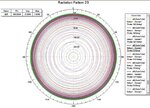bijus
Member level 1

- Joined
- Apr 11, 2013
- Messages
- 34
- Helped
- 0
- Reputation
- 0
- Reaction score
- 0
- Trophy points
- 1,286
- Location
- India
- Activity points
- 1,534
Dear all,
I am a beginner in this field HFSS. I would like to design a monopole antenna in HFSS. I have completed the preliminary stage up to my knowledge and i have some doubts about the measurements and report generation.
I tried the design of monopole using both lump port and wave port. Pls suggest which is good. Attached both simulation files and test results.
The VSWR is ok and provided the details of the test report I have with me.
In HFSS, i had added the far-field option for generating reports.
The elevation pattern is seems good. Now i want to know how we will measure the H Plane pattern (Omni Directional) / how we will generate the report of H Plane Pattern.
Pls help me to measure/see the H plane Pattern and also the exact absolute gain figure. Also pls advise the steps to be followed to measure the same.
Your valuable suggestions requested....
Pls Help.....
T&R
I am a beginner in this field HFSS. I would like to design a monopole antenna in HFSS. I have completed the preliminary stage up to my knowledge and i have some doubts about the measurements and report generation.
I tried the design of monopole using both lump port and wave port. Pls suggest which is good. Attached both simulation files and test results.
The VSWR is ok and provided the details of the test report I have with me.
In HFSS, i had added the far-field option for generating reports.
The elevation pattern is seems good. Now i want to know how we will measure the H Plane pattern (Omni Directional) / how we will generate the report of H Plane Pattern.
Pls help me to measure/see the H plane Pattern and also the exact absolute gain figure. Also pls advise the steps to be followed to measure the same.
Your valuable suggestions requested....
Pls Help.....
T&R





